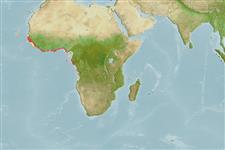>
Eupercaria/misc (Various families in series Eupercaria) >
Haemulidae (Grunts) > Plectorhinchinae
Etymology: Plectorhinchus: Greek, plektos = plaited + Greek, rhyngchos = snout (Ref. 45335).
More on author: Boulenger.
Environment: milieu / climate zone / depth range / distribution range
Ökologie
seewasser; brackwasser benthopelagisch; tiefenbereich 10 - ? m (Ref. 2683). Tropical; 15°N - 13°S
Eastern Atlantic: west African coast, from Senegal to Democratic Republic of Congo (Ref. 81655) and Angola (Ref. 7376, 57395).
Size / Gewicht / Alter
Maturity: Lm ? range ? - ? cm
Max length : 45.0 cm TL Männchen/unbestimmt; (Ref. 5476); common length : 30.0 cm TL Männchen/unbestimmt; (Ref. 5476)
Rückenflossenstacheln (insgesamt): 14; Rückenflossenweichstrahlen (insgesamt): 16; Afterflossenstacheln 3; Afterflossenweichstrahlen: 7. Diagnosis: body oblong, rather deep; dorsal profile strongly convex at level of dorsal-fin origin (Ref. 57395). Snout at least as long as eye diameter (Ref. 57395), eyes large (Ref. 81655). Mouth oblique (Ref. 57395), small (Ref. 81655) with very thick (Ref. 57395) and fleshy (Ref. 81655) lips. Chin with 6 pores (erroneously reported as 4 since original species description; Ref. 81655), but without median pit (Ref. 57395). Dorsal fin long; second anal fin spine longest and stoutest; ctenoid scales covering body and head (except snout) and interradial membranes of soft parts of dorsal and anal fins (Ref. 57395). Caudal fin rounded (Ref. 57395, 81655).
Coloration: uniformly brown, more or less dark; young individuals often with lighter spots on flanks (Ref. 57395, 81655). In small specimens (< 60 mm SL), distal part of soft dorsal fin, posterior 3/4 of caudal fin and distal part of anal fin transparent (Ref. 81655).
Relatively rare species (Ref. 57395). Inhabits coastal waters (Ref. 3660, 57395), estuaries and coastal lagoons (Ref. 2683). Juveniles and sub-adults often in estuaries and lagoons (Ref. 2135, 57395, 81655), in freshwater (Ref. 2135), where sexual maturation begins (Ref. 57395).
Life cycle and mating behavior
Geschlechtsreife | Fortpflanzung | Ablaichen | Eier | Fecundity | Larven
Oviparous, distinct pairing during breeding (Ref. 205).
Roux, C., 1990. Haemulidae. p. 783-788. In J.C. Quero, J.C. Hureau, C. Karrer, A. Post and L. Saldanha (eds.) Check-list of the fishes of the eastern tropical Atlantic (CLOFETA). JNICT, Lisbon; SEI, Paris; and UNESCO, Paris. Vol. 2. (Ref. 6946)
IUCN Rote Liste Status (Ref. 130435)
Bedrohung für Menschen
Harmless
Nutzung durch Menschen
Fischereien: kommerziell
Mehr Information
ReferenzenAquakulturAquakultur ProfilZuchtlinienGenetikElectrophoresesVererbbarkeitKrankheitenVerarbeitungNutrientsMass conversion
PartnerBilderStamps, Coins Misc.LauteCiguateraGeschwindigkeitSchwimmstilKiemenoberflächeOtolithsGehirngrößeSehfähigkeit
Tools
Zusatzinformationen
Download XML
Internet Quellen
Estimates based on models
Preferred temperature (Ref.
123201): 22.6 - 27.9, mean 26.3 °C (based on 40 cells).
Phylogenetic diversity index (Ref.
82804): PD
50 = 0.5000 [Uniqueness, from 0.5 = low to 2.0 = high].
Bayesian length-weight: a=0.01950 (0.00846 - 0.04494), b=2.95 (2.75 - 3.15), in cm total length, based on LWR estimates for this (Sub)family-body shape (Ref.
93245).
Trophic level (Ref.
69278): 3.7 ±0.6 se; based on size and trophs of closest relatives
Widerstandsfähigkeit (Ref.
120179): mittel, Verdopplung der Population dauert 1,4 - 4,4 Jahre. (Preliminary K or Fecundity.).
Fishing Vulnerability (Ref.
59153): Low to moderate vulnerability (35 of 100).
Climate Vulnerability (Ref.
125649): Very high vulnerability (89 of 100).
Nutrients (Ref.
124155): Calcium = 72.6 [20.8, 161.1] mg/100g; Iron = 0.726 [0.384, 1.531] mg/100g; Protein = 17.8 [15.9, 19.8] %; Omega3 = 0.176 [0.077, 0.347] g/100g; Selenium = 56.4 [26.6, 114.0] μg/100g; VitaminA = 20.4 [7.2, 56.7] μg/100g; Zinc = 1.19 [0.77, 1.83] mg/100g (wet weight);
